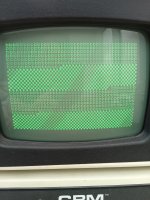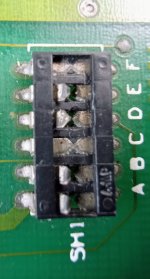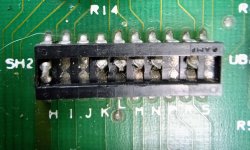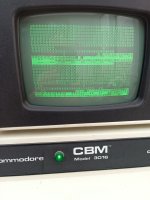Bagpuss
Member
Hi, ina. Bit of a dilemma with my PET
I burned the diagnostic edit ROM from Daver2.
I replaced the static ram as they were bad. I replaced the CPU with a good working one as I suspected that.
I've pulled the 3 I/O chips to be safe and eliminate them interfering.
So far on the diagnostics of zero page it's giving me $FF for all reads. I replaced the 74LS244 buffers closes to the dram and tested the lower 3 4116 to make sure they were good (not done the whole lot but at least checked a sample set).
Given that the screen is good I expect E9 and E10 are good. If I pull the 244s buffers near the dram it continues to give $FF. Those chips test OK in my tester as well.
I was thinking next, is the dram refresh circuit bad causing the dram to loose values, but that doesn't seem to be the case (or at least as far as my oscilloscope skills get me, I can see RAS0 toggling).
I'm kind of at a loss now on where to go next. DRAM and buffers test good. Address decoding should be right else the ROMs wouldn't work. I can see CAS0 strobing so address decoding to zero page must be at least reasonably OK.
Refresh seems to be doing something.
Crystal gives 16MhZ,, 1MHz clock is good, sync must be working as the ROM diag runs, interrupt is high, clocks on CPU are good, else it wouldn't run. Just seems the DRAM circuit will only ever return $FF.
I'm thinking next use a logic analyser and pulse values into output pins of selective 4116 chips.
I've ordered a romulator from bitfixer but not hear anything yet and shipping to UK is a job in its own right these days.
I burned the diagnostic edit ROM from Daver2.
I replaced the static ram as they were bad. I replaced the CPU with a good working one as I suspected that.
I've pulled the 3 I/O chips to be safe and eliminate them interfering.
So far on the diagnostics of zero page it's giving me $FF for all reads. I replaced the 74LS244 buffers closes to the dram and tested the lower 3 4116 to make sure they were good (not done the whole lot but at least checked a sample set).
Given that the screen is good I expect E9 and E10 are good. If I pull the 244s buffers near the dram it continues to give $FF. Those chips test OK in my tester as well.
I was thinking next, is the dram refresh circuit bad causing the dram to loose values, but that doesn't seem to be the case (or at least as far as my oscilloscope skills get me, I can see RAS0 toggling).
I'm kind of at a loss now on where to go next. DRAM and buffers test good. Address decoding should be right else the ROMs wouldn't work. I can see CAS0 strobing so address decoding to zero page must be at least reasonably OK.
Refresh seems to be doing something.
Crystal gives 16MhZ,, 1MHz clock is good, sync must be working as the ROM diag runs, interrupt is high, clocks on CPU are good, else it wouldn't run. Just seems the DRAM circuit will only ever return $FF.
I'm thinking next use a logic analyser and pulse values into output pins of selective 4116 chips.
I've ordered a romulator from bitfixer but not hear anything yet and shipping to UK is a job in its own right these days.





